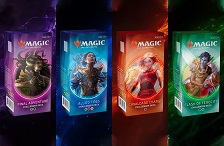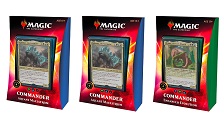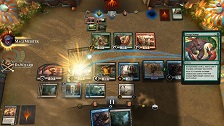Here, we’ll take you through a few different formats and give you the low-down on where you can save pennies while still remaining competitive, with a budget of around £50-70 as a guideline, and avoiding formats like Pioneer and Modern where the price of competitive decks are considerably out of budget.
Standard
Standard is the default format for a lot of new players – it only uses the last 4-8 card sets that are legal for the format, and thus rotates a lot of cards out of the format once a year. Out of many formats, it’s also often the cheapest – cards being new on the market and sold in current sets mean you’re not hunting for an old, hard-to-find copy of a certain card on the secondary market, which helps keep the cost down.
To minimize costs, we recommend starting with one of Wizards of the Coast’s own Challenger Decks. These are reasonably priced (the exact price depends on where you buy it) pre-built decks based on some of the most competitive designs in the format. They’re not quite as powerful as the designs they’re based on, to balance cost vs. contents, but one of them is an absolute powerhouse with a relatively affordable upgrade path: mono red.

Mono red means it only uses red mana and colorless spells, so you’ll never need to seriously upgrade the mana base. As an archetype, it is an extremely fast and aggressive deck that aims to kill the opponent before they’ve had time to blink. The design is simple as a result, and almost every core card is in the box – you could easily take this to a Friday Night Magic tournament and clean up because its design is so reliable.
Pauper
Pauper is a format that, as its name suggests, operates on the idea of low cost – no card in your deck can be above common in rarity. What does this mean? A load of variety and choice where tactics are favoured over raw power, and an affordable collection of cards to choose from.
This means if you want to try out multicolour decks that do everything from sneakily control the battlefield to deploying giant stompy monsters, you’re in luck! The meta (the current landscape of the game, competitively) contains a ton of affordable decks – jump into the format with this helpful video.
Commander
Commander is a little different to most Magic, in that you have a commander – a legendary (unique) named character whose identity, from their abilities to the mana colors used to summon them and use said abilities, define the colors of cards you can include in your whopping 99-card deck. Every card must be unique (with some exceptions, and your basic land cards), and games are often played in groups of 3-4 rather than a 1v1 format.
All these cards, all that power, and a card legality that goes back to the beginning of Magic means that some of these decks cost thousands of dollars. But your saving grace comes in the form of deck designers like Commander’s Quarters, who will present you with countless fun and competitive decks that sync nicely to your budget.
If you do put together a Commander deck, and find a group of friends to play with, it’s also important to make sure the power level of everyone’s decks will match up so your budget creation doesn’t leave you DOA with your friends playing the rest of the game. Not sure how to approach that conversation? This article is a great starting point.

Digital Magic
If you’re some distance from your nearest Magic spot, or like many of us, avoiding in-person gatherings during COVID-19, then have no fear – digital Magic is here! The go-to for many new players is Magic the Gathering: Arena, a PC digitization of the Standard format (and a fair few others besides) that is free to download and play – and comes with ten starter decks. Earning new cards is simple (and still free), and most tournament events are accessible via currency that isn’t tied to your wallet.
There’s also Magic the Gathering: Online, or MTGO for short. Also digital, but it comes with an actual real-money marketplace, and the ability to play every major Magic format from throughout the game’s history. You can even cheaply rent expensive decks to try them out before you commit to buying the cards – great for the money-savvy player on a budget.

Shuffle Up and Play
No matter whether you start with Standard, Commander or even formats beyond it like Limited, Modern, Pioneer, Legacy and more, the best thing to do is sit down, shuffle up and play. You’ll soon get a feel for what decks you like and dislike, and the secondary card market means trading your own physical (or on MTGO, digital) cards in to change decks is perfectly possible at many local game stores. We look forward to seeing you on the battlefield!